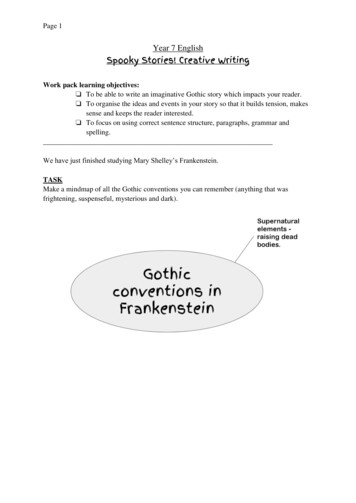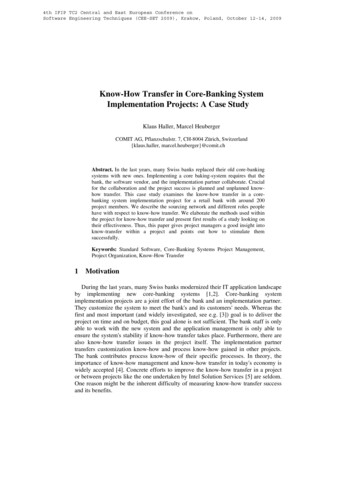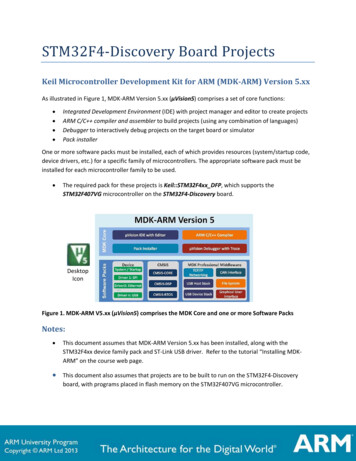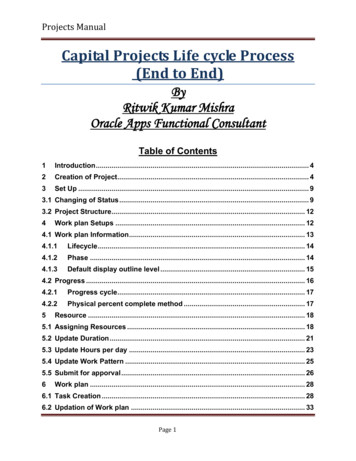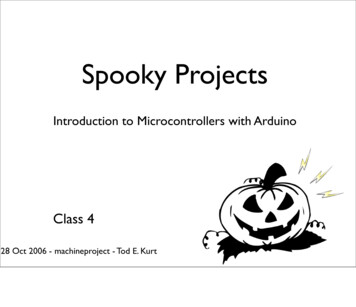
Transcription
Spooky ProjectsIntroduction to Microcontrollers with ArduinoClass 428 Oct 2006 - machineproject - Tod E. Kurt
What’s For Today Switches without Resistors All about piezos Building a melody player Using piezos as pressure & knock sensors Using Processing with Arduino Stand-alone Arduino
Recap: ProgrammingEditCompileResetUploadLike always, just make sure. Make “led blink” come alive again. Do it. Trust me.
Switches w/o ResistorsAVR chip has internal “pull-up” resistorsInstead of this:You can just do this: 5V10kto inputto inputBut how do you turn on these internal pull-ups?This is sort of an aside, but it saves a lot of wiring.
Switches w/o ResistorsAnswer: use digitalWrite(pin,HIGH) on the inputArduinoboardpin 7pin 6pin 5gndABCSeems a little counter-intuitive,think of it as setting the default value of the inputbut note, it doesn’t work the other way: you can’t set it to LOW then wire the switch to 5V.
Switches w/o ResistorsCan make a button box easilyif no resistors are neededPlugs right into Arduino board ABC
Piezoelectrics Big word – piezein is greek for “squeeze” Some crystals, when squeezed, make a spark Turns out the process goes the other way too Spark a quartz crystal, and it flexesbuzzers use this to make sound Piezo(flex something back and forth, it moves air)Piezo buzzers don’t have quartz crystals, but instead a kind of ceramic that also exhibitspiezoelectric properties.I pronounce it “pie-zoh”. Or sometimes “pee-ay-zoh”.
Piezo Buzzers Two wires, red & black.Polarity matters: black ground Apply an oscillating voltage tomake a noise The buzzer case supports thepiezo element and hasresonant cavity for soundOscillating voltage alternately squeezes and releases the piezo element.Must apply flucuating voltage, a steady HIGH or LOW won’t work.diagrams from:http://www.maxim-ic.com/appnotes.cfm/appnote number/988
What’s in a Piezo Buzzer?You can get at the piezoelement pretty easily.Be careful not to crackthe white disc that isthe actual piezoOnly take it out of itscase to use it as asensoranother 1.99 I won’t be getting back from Radio ShackOf course, you usually destroy the enclosure to get at the element.And it’s the enclosure that has the proper support and resonant cavity to make a loud sound
Piezo BuzzerpiezobuzzerArduinoboardpin 7 –gndPiezo leads are very thin. The breadboard holes grab them better than the header sockets, which iswhy the jumper leads are used.
Play a Melody“sound serial”Play the piezo beeperwith the Serial MonitorType multiple lettersfrom “cdefgabC” tomake melodiesThis sketch is in the handout, and is based on “Examples/pwm sound/keyboard serial”Notice the problem with this sketch?Different notes play for different amounts of time.50 cycles of low C isn’t the same amount of time as 50 cycles of high B
Making it QuieterEasiest way: add a resistorArduinoboard10kpin 7gnd(brown,black,orange) –piezobuzzerLike most things in electronics, if you want less of something, add a resistor.A better value would probably be 1k, but we don’t have that on hand.This may not seem important now, but wait for the next project.
Play a Stored Melody“play melody”Plays a melody storedin the ArduinoThis is in the handout, but is also in “Examples/pwm sound/play melody” (pin changed)Melody definition is sort of like the old cell ringtone styleMelody playing logic is hard to follow.
Make a Theremin“ooo-weee-ooooo”The original spookysound machineWorks by measuring yourbody’s electric fieldNo touching needed!We’ll use light in lieu of RFLeon ThereminAs heard on Star Trek, Beach Boys, horror movies, Mars Attacks!, and bad New Age songs.Works sorta like those touch switches, but no touching here.That is, your body becomes a variable capacitor.
Make a ThereminTake photocell circuit from before, bolt it on 5VpiezobuzzerArduinoboardpin 7photocellanalog pin 010k(brown,black,orange) –gndThis is a light-to-sound converter, if you will.
Make a Theremin“theremin”Move hand overphotocell tochange pitchPlay with val processing & cycles countto alter sensitivity, pitch and timbreThis is frequency modulation,since you’re changing the frequencyOkay so maybe it sounds more like a bad video game than a spooky movieThe glitchy sound is cause because of the time it takes to read the sensorThere are ways around such stuff, but requires more complex programming using timers &interruptsThe sound can get annoying quick
Piezo Buzzer as Sensor Piezo buzzers exhibit the reverse piezoelectriceffect. The normal piezoelectric effect is generatingelectricity from squeezing a crystal. Can get several thousand volts, makes a spark You probably have seen a big example of thisalready:fireplace lighterI have a demo piezo igniter from one of these lighters. It’s fun to shock yourself.Puts out several thousand volts. (ionization voltage of air 30kV/cm)
Piezo Read To read a piezo you canjust hook it into ananalog input, but:You need to drain offany voltage with aresistor, or it just buildsupYou should have aprotection diode tolimit big voltages, elsefry your inputsArduinoboardpiezobuzzer –analog pin 05.1vzener1Mgnd(brown,black,green)piezo input schematicNote polarity of piezo still matters.The protection diode is a special kind of diode called a “zener diode”. It acts invisible until thevoltage gets over its designed value (5.1 volts in this case), then it acts like a short circuit.
Piezo ReadArduinoboardpiezobuzzer –analog pin 05.1vzener1Mgnd(brown,black,green)Create two little busses for GND and A0, and hook components across it.Black bar on diode indicates “bar” of diode.
Piezo Read“piezo read”Whack the piezo togenerate a numberbased on force ofwhackWaits for input to go over threshold,then to drop below thresholdNumber is “t”, the number of times it looped waiting for the value to drop below THRESHOLD/2.
How Does that Work? When a piezo is struck, it “rings” like a bell But instead of sound, it outputs voltage The sketch measures time above a certainvoltsvoltage, hoping to catch largest ringpiezo output voltagethresholdtimewhack!tDepending on how fast you can watch the input, this technique works either really well or not thatwell. There are much faster ways of watching inputs that loops with analogRead()But for now it works okay
Custom Piezo SensorsCan mount the element on anything(floor mat, door, your body, etc.)Here’s one glued to a larger brass disc for a drum trigger
Take a Break(see Craft magazine!)
Processing Processing makes Java programmingas fun & easy as Arduino makes AVRprogramming Started as a tool to make generativeart Is also often used to interface todevices like ArduinoAnd it’s totally open source like Arduino.Processing GUI and Arduino GUI are from the same code, which is why it looks & acts similar.
Using Processing First, installProcessingup Load“Sketchbook »Examples »Motion » Bounce” Press “Run”button You just made aJava appletThe Processing application folders are in the handout, no installation is needed.Also try Examples » Motion » Collision. It’s a lot of fun.Notice how “Run” launches a new window containing the sketch.The black area at the bottom is a status window, just like in Arduino.
About Processing Processing sketches have very similar structureto Arduino sketches setup() – set up sketch, like size, framerate draw() – like loop(), called repeatedly Other functions can exist when using libraries
Processing & Arduinoserial communications Processing and Arduino both talk to “serial”devices like the Arduino board Only one program per serial port So turn off Arduino’s Serial Monitor when connectingvia Processing and vice-versa. Processing has a “Serial” library to talk toArduino. E.g.:port new Serial(.,“my port name”,9600)port.read(), port.write(), etc.serialEvent() { }Using the serial library adds a new function you can use to your sketch: serialEvent()The serialEvent() function will get called whenever serial data is available.
Processing Serialcommon Processing serial usefour steps1. load library2. set portname3. open port4. read/write port1.2.3.be sure to set tothe same as“Serial Port” inArduino GUI4.All you need to do talk to Arduino in Processing.The import statement says you want to do serial stuff.The “new Serial” creates a serial port object within ProcessingThen you can that object (or used the passed in one) to read from in the “serialEvent()” function
Processing & Arduino“arduino ball”Every time a numberis received via theserial port, it draws aball that size.Use “piezo read”Arduino sketch frombeforeThis sketch is in the handout.Uses “serialEvent()” and “read()” to build up a string and then parse it into a number with “int()”
Spookier, Please“arduinospookysounds”Every time thepiezo is knocked.a scary eye opensand a spookysound playspiezo val is printed, but notused: just its existance isThis sketch is in the handout.You can add your own sounds (must be 16-bit WAV or AIFF).Hook a piezo up to your front door, and plug your computer into your stereo.Every time someone knocks on your door, a scary sound is played
Processing to Arduinoreal quick“http rgb led”Fetch a web page,get a color value fromit, send the color toArduino with RGB LEDThis is not to build, just quickly cover. It’s not in the handout, but,full details at: with-arduino-update/
Fun Uses
External PowerArduino can run off USB power or external powerExternal power connectorUSB connectorvoltageregulatorjumper switch to choose power source
External PowerYou can use an AC adpaterConnector isstandard barrelconnectorMake sure it’s“center positive”Voltage can be9-15 V DCcenterpositiveAmps is 200mAActually input voltage can be from like 7.5V to 35V, but don’t go over 15V so the voltage regulatordoesn’t have to work so hard.
External PowerOr you can use a batteryBe careful about polarity! And shorts!On the prototyping shield you plug in on top, the “9V” socket is called “raw”
External PowerAn easier way to connect a batteryalso solves polarity concernsPower connector input has protection diode.Also it’s easier with the connector
External PowerBattery lifeHow long does Arduino last on 9V battery? Arduino board draws about 40 mA by itselfEach LED adds about 20mA when onEach servo maybe 100 mA when runningSwitches, pots, etc. are effectively zeroBattery capacity rated in milliamp-hours (mAh)9V batteries have about 400 mAh capacityThus, Arduino by itself lasts 400/40 10 hoursTake all your power, add it up, divide it into your battery capacity to get time in hours.There are techniques to make an AVR chip go into sleep mode, and draw microamps (1/1000 mA),but those techniques don’t have nice Arduino-style wrappers yet.For more on batteries and their capacities: http://en.wikipedia.org/wiki/List of battery sizes
SummaryYou’ve learned many different physical building blocksresistive rvos
SummaryAnd you’ve learned many software building blocksserialcommunicationpulse widthmodulationdigital I/Odata drivencodemultiple tasksanalog I/Ofrequencymodulation
SummarySome things we didn’t cover, like: 5VDC motorArduinoboardpin 71kM 5V1N40041N4004Arduinoboardpin 7TIP120gnd1kTIP120gndmotorsrelaysBut they use concepts you know5V relayto load
SummaryHope you had fun and learned somethingFeel free to contact me to chat about this stuff
END Class 4http://todbot.com/blog/spookyarduinoTod E. Kurttod@todbot.com
A little extra: MIDICombine everything, add a MIDI jackArduinoboardpiezobuzzerpin 7pin 6pin 5 –analog 05.1vzenergndpin 1A1MBCMIDI jack 5V31524220
A little extra: MIDI
A little extra: MIDIsends MIDI note-on & note-off messagesMIDI is just serial at 31250 baudbuttons are drum triggers
end
Processing & Arduino Processing and Arduino both talk to “serial” devices like the Arduino board Only one program per serial port So turn off Arduino’s Serial Monitor when connecting via Processing and vice-versa. Processing has a “Serial” library to talk

